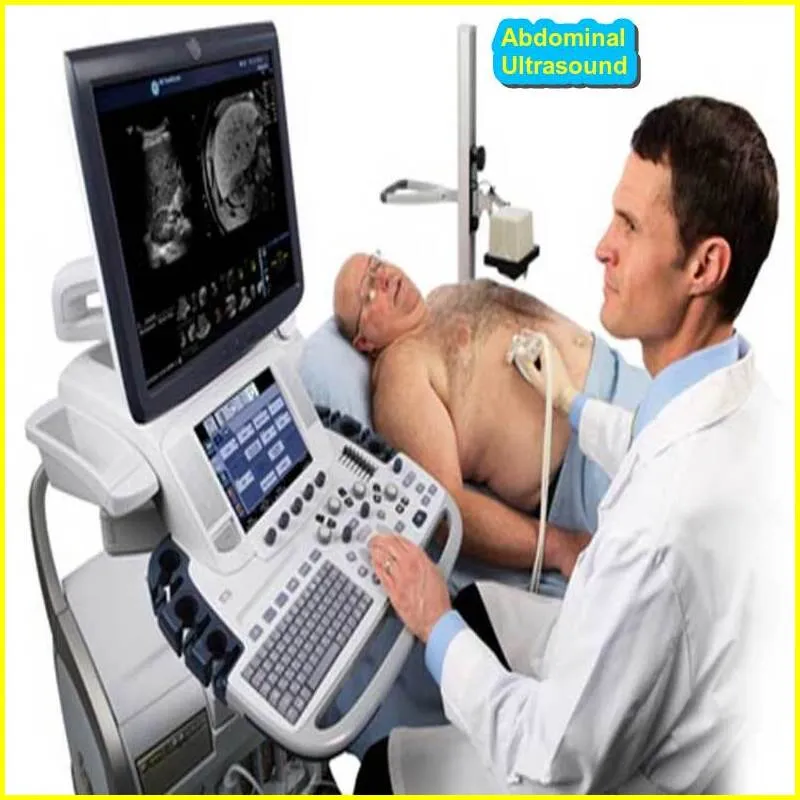What is the Abdominal Ultrasound
Imaging is a form of ultrasound. It creates images of structures inside your body using sound waves. An abdominal ultrasound is a test that is performed to evaluate the organs and tissues in your abdomen. The stomach, liver, spleen, pancreas, and kidneys are all located in the abdomen. Abdominal ultrasonography can be used to check and diagnose these organs. The test is also used to monitor a fetus’s health throughout pregnancy. Ultrasound is non-harmful and does not emit ionizing radiation. An abdominal ultrasound may be performed as part of a standard physical assessment.
Abdominal Ultrasound
An abdominal ultrasound is a diagnostic tool used to assess the organs and structures within the abdomen. This non-invasive test uses high-frequency sound waves to produce images of the inside of the abdomen.
An abdominal ultrasound is used to analyze the organs and structures of the abdomen, such as the stomach, liver, gallbladder, pancreas, spleen, and kidneys. Ultrasound can also be used to measure blood flow in the abdomen’s arteries and veins.
Abdominal ultrasonography is completely risk-free. This painless and safe process takes only a few minutes to perform.
During an abdominal ultrasound, gel is applied to the skin on your abdomen. A small hand-held device called a transducer is then placed on the gel and moved over your abdomen in order to obtain images of the internal organs and structures. The transducer emits sound waves that bounce off of the organs and structures being imaged. These sound waves are then converted into electrical signals that are interpreted by a computer to create images.
Abdominal Ultrasound Fasting
An abdominal ultrasound is a diagnostic imaging test that uses high-frequency sound waves to produce pictures of the structures inside your abdomen. The images can be used to evaluate the organs and blood vessels in your abdomen.
An abdominal ultrasound is typically performed as an outpatient procedure. You will likely be asked to fast for four to six hours before the test. This means you should not eat or drink anything during that time. Fasting allows your stomach and intestines to be empty so the ultrasound images are clear.
You will be asked to lie on your back on an examination table. A gel will be applied to your abdomen and a hand-held device called a transducer will be placed against your skin. The transducer emits sound waves that bounce off your organs and tissues. The echoes are then converted into electrical signals that produce images on a monitor.
The entire procedure usually takes less than 30 minutes. There is no recovery time, and you can resume your normal activities immediately after the test.
Article About:- Health & fitness
Article About:- Medical Technology
Article About:- Sports

Signs of a Bad Abdominal Ultrasound
There are a few signs that may indicate that an abdominals ultrasound is not accurate. If the person being scanned is obese, the ultrasound waves may have difficulty penetrating through the layers of fat. This can lead to inaccurate results. In addition, if there is a lot of gas in the intestines, this can also interfere with the accuracy of the ultrasound.
cpt code for Abdominal Ultrasound
An abdominel ultrasound is a diagnostic tool used to visualize the organs and structures within the abdomen. The test is performed by a trained ultrasonographer, who will use a transducer to produce sound waves that create an image of the inside of the abdomen on a monitor.
The purpose of an abdominel ultrasound is to assess the organs and structures within the abdomen for any abnormalities. The test can be used to diagnose a wide variety of conditions, such as liver disease, gallstones, kidney stones, pancreatitis, and abdominal tumors.
There are no risks associated with having an abdominal ultrasound. The procedure is non-invasive and does not use ionizing radiation, so it is considered safe for both adults and children.
The abdominal ultrasound procedure typically takes 30-60 minutes to complete. During the procedure, you will be asked to lie on your back on an exam table. A gel will be applied to your abdomen in order to help the transducer make contact with your skin. The transducer will then be moved over your abdomen in order to obtain images from different angles.
What does an Abdominal Ultrasound Show
An abdominal ultrasound is a medical test that uses sound waves to create pictures of the inside of your abdomen. This test can help your doctor evaluate the cause of abdominal pain or bloating. It can also be used to check for problems with your liver, pancreas, and gallbladder. Abdominal ultrasounds are usually done as outpatient procedures, which means you won’t need to stay in a hospital overnight.

Abdominal Ultrasound Prep
An abdominal ultrasound is a noninvasive diagnostic exam that produces images of the organs and structures within the abdomen. The test is also called a sonogram or ultrasound scan.
Ultrasound waves are used to create images of the inside of the body. The waves are sent through a transducer, or hand-held probe, that is placed on the skin surface. The transducer transmits the waves into the body and picks up the echoes as they bounce off organs and tissue structures. A computer converts the echoes into black and white images.
The abdominal ultrasound procedure is usually performed in an outpatient setting. No special preparation is needed, although you may be asked to fast for four to six hours before the test if your gallbladder will be examined.
What are the risks of abdominal ultrasound?
There is no risk in abdominal ultrasound. Unlike X-rays or CT scans, ultrasounds do not use radiation, which is why doctors prefer to use them mostly in pregnant women to examine developing babies.
Fetal ultrasound imaging provides real-time images of the fetus. US The Food and Drug AdministrationTrusted Source advises parents to have ultrasound scans only if there is a specific medical need. Nothing is gained by exposing the fetus to unnecessary additional ultrasounds, so the FDA advises against these “keepsake videos”.
There is no evidence that ultrasound imaging and heartbeat monitors cause any harm to the fetus. Even so, doctors still can’t be sure there is no longer a risk. Ultrasound can slightly warm the tissues in the abdomen. In some cases, it can form very small bubbles in some tissues. Its long term effects are not known.
What abdominal ultrasound can detect?

An abdominal ultrasound can indicate conditions such as:
Abdominal aortic aneurysm.
Abscess.
Appendicitis.
Cholecystitis.
Gallstones.
Hydronephrosis.
Kidney stones.
Pancreatitis (inflammation in pancreas)
what can an abdominal ultrasound detect?

An abdominal ultrasound can indicate conditions such as:
Abdominal aortic aneurysm.
Abscess.
Appendicitis.
Cholecystitis.
Gallstones.
Hydronephrosis.
Kidney stones.
Pancreatitis (inflammation in pancreas)
Why would a doctor order an abdominal ultrasound?

Doctors order an abdominal ultrasound when they’re concerned about symptoms such as belly pain, repeated vomiting, abnormal liver or kidney function tests, or a swollen belly. The tests can show them the size of the abdominal organs and help them check for injuries to or diseases of the organs.
Can I drink water before an abdominal ultrasound?

You must not eat or drink for eight hours before your exam. Water and taking medication is okay. If ultrasound pelvis is also being done, for female patients, please drink 32 ounces of water one hour before the scan. You can go to the bathroom to relieve yourself, as long as you keep drinking water.
Can abdominal ultrasound detect gas?

The diagnosis of pneumoperitoneum, whether by plain xray, CT or ultrasound relies upon the detection of gas in the abdomen outside its usual position, i.e. outside the bowel lumen. Due to it’s low density, gas will generally move in an anti‐gravitational direction to the most elevated areas.
Can ultrasound detect stomach ulcer?

Ultrasound technology cannot find ulcers, but other types of diagnostic tests can. Doctors usually request a test for the bacteria that causes stomach ulcers, an x-ray series or an endoscopy. Some research explores the potential for finding ulcers with an ultrasound, but experts do not have enough data to recommend it.
What are the side effects of abdominal ultrasound?

Unlike X-rays, ultrasound does not use radiation (which can cause medical issues at high doses). Ultrasound has no known side effects.
How long does a abdominal ultrasound take?

The test will take about 30 minutes. You may be asked to wait until the radiologist has reviewed the scan. He or she may want to do more ultrasound views of some areas of your belly.
Will an abdominal ultrasound show a blockage?

Ultrasound can play an important role in the identification of small bowel obstructions in ED patients.
What are the symptoms of abdominal blockage?

Symptoms of intestinal obstruction are:
Severe pain in your belly.
Severe cramping sensations in your belly.
Throwing up.
Feelings of fullness or swelling in your belly.
Loud sounds from your belly.
Feeling gassy, but being unable to pass gas.
Constipation (being unable to pass stool)
Pocket Anatomy & Protocols for Abdominal Ultrasound First Edition




